新目标英语八年级上册Unit1-12学案与练习(全册)
- 格式:doc
- 大小:584.50 KB
- 文档页数:93
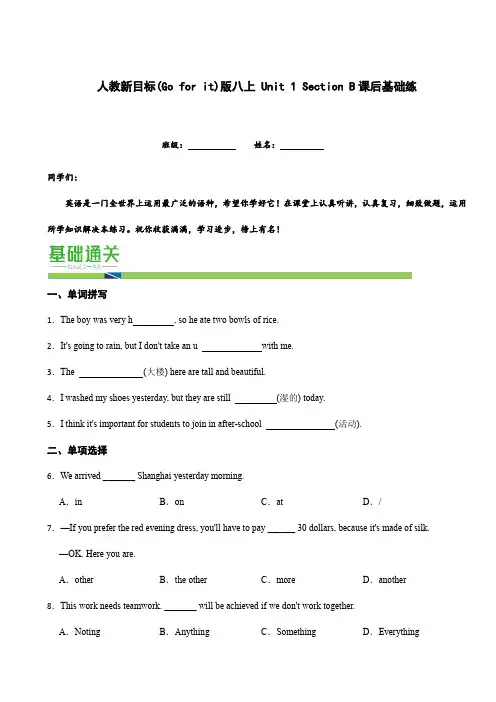
人教新目标(Go for it)版八上 Unit 1 Section B课后基础练班级:姓名:同学们:英语是一门全世界上运用最广泛的语种,希望你学好它!在课堂上认真听讲,认真复习,细致做题,运用所学知识解决本练习。
祝你收获满满,学习进步,榜上有名!一、单词拼写1.The boy was very h, so he ate two bowls of rice.2.It's going to rain, but I don't take an u with me.3.The (大楼) here are tall and beautiful.4.I washed my shoes yesterday, but they are still (湿的) today.5.I think it's important for students to join in after-school (活动).二、单项选择6.We arrived _______ Shanghai yesterday morning.A.in B.on C.at D./7.—If you prefer the red evening dress, you'll have to pay ______ 30 dollars, because it's made of silk.—OK. Here you are.A.other B.the other C.more D.another8.This work needs teamwork. _______ will be achieved if we don't work together.A.Noting B.Anything C.Something D.Everything9.Leo was so _______ that he rushed to the kitchen, hoping to find something to eat.A.thirsty B.hungry C.tired D.sleepy 10.— How was your vacation?— ________. I just stayed at home.A.Thanks a lot B.Good luckC.Nothing special D.I see11.We need ________ players to play basketball. Would you like to join us?A.another two B.two another C.more two D.every two 12.— Does Tom go to school?— Yes. He is ________ to go to school.A.enough old B.young enough C.old enough D.enough young 13.This movie wasn't . He fell asleep half way through it.A.interesting enough B.enough interestingC.interested enough D.enough interested14.It was dark outside, Sue decided to the bank alone.A.not going B.going not C.not to go D.to not go 15.funny the joke is! It makes us smile from ear to ear.A.What an B.What C.How an D.How三、句型转换16.We stayed at home because it rained heavily. (改为同义句)We stayed at home the heavy rain.17.What was the weather like yesterday? (改为同义句)the weather yesterday?18.I want to go somewhere interesting. (改为一般疑问句)you want to go interesting?19.The girl helped her mother look after her little sister last Sunday. (对划线部分提问)the girl last Sunday?20.She wanted to buy something here. (改为一般疑问句)she to buy here?四、翻译21.她太小了,骑不了自行车。
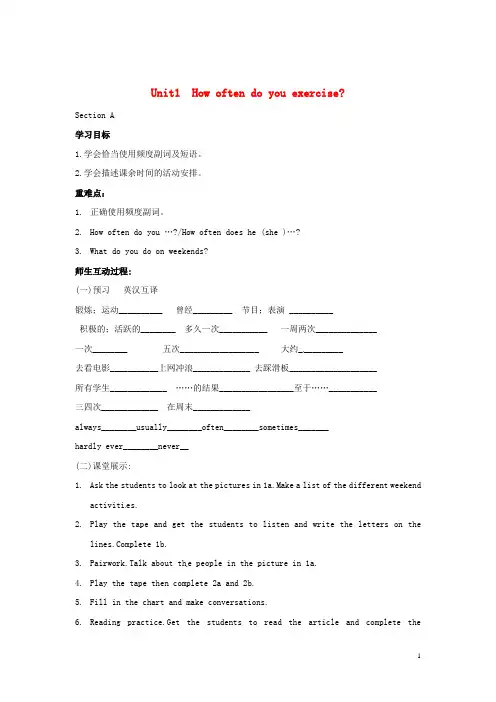
Unit1 How often do you exercise?Section A学习目标1.学会恰当使用频度副词及短语。
2.学会描述课余时间的活动安排。
重难点:1.正确使用频度副词。
2.How often do you …?/How often does he (she )…?3.What do you do on weekends?师生互动过程:(一)预习英汉互译锻炼;运动__________ 曾经_________ 节目;表演 __________积极的;活跃的________ 多久一次___________ 一周两次______________一次________ 五次__________________ 大约__________去看电影___________上网冲浪_____________ 去踩滑板____________________所有学生_____________ ……的结果_________________至于……___________三四次_____________ 在周末_____________always________usually________often________sometimes_______hardly ever________never__(二)课堂展示:1.Ask the students to look at the pictures in 1a.Make a list of the different weekendactiviti es.2.Play the tape and get the students to listen and write the letters on theplete 1b.3.Pairwork.Talk about th e people in the picture in 1a.4.Play the tape then complete 2a and 2b.5.Fill in the chart and make conversations.6.Reading practice.Get the students to read the article and complete thee the information in the boxes. Complete 3.7.Groupwork Find the best Engli sh student in your class.巩固测评(一)根据句意及首字母提示完成对话.A:________do you do ______ weekends?B:I surf the I___________.A:________ ________ do you do that?B:T_________ a week. What about you ?A: I stay at home and do my homework.B:_______ ______ do you do your homework?A:Always.B;Oh,you are a good student.(二)单项填空1.Tom hardly ever______sports news ____TV on weekends.A. watch; in B .watching; on C .watches ; on2. ______do you read English books? ----Every day.A.How many timesB.WhenC..How often3.We _____go out to have dinner,but not very often .A .sometimes B.never C. hardly ever4.Our math teacher_____every day.A. exercise B .exercises C. is exercising(三)写一篇日记。
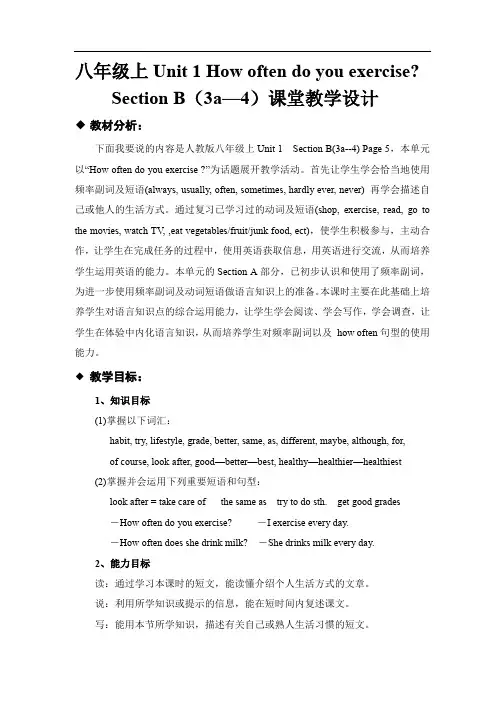
八年级上Unit 1 How often do you exercise?Section B(3a—4)课堂教学设计◆教材分析:下面我要说的内容是人教版八年级上Unit 1 Section B(3a--4) Page 5,本单元以“How often do you exercise ?”为话题展开教学活动。
首先让学生学会恰当地使用频率副词及短语(always, usually, often, sometimes, hardly ever, never) 再学会描述自己或他人的生活方式。
通过复习已学习过的动词及短语(shop, exercise, read, go to the movies, watch TV, ,eat vegetables/fruit/junk food, ect),使学生积极参与,主动合作,让学生在完成任务的过程中,使用英语获取信息,用英语进行交流,从而培养学生运用英语的能力。
本单元的Section A部分,已初步认识和使用了频率副词,为进一步使用频率副词及动词短语做语言知识上的准备。
本课时主要在此基础上培养学生对语言知识点的综合运用能力,让学生学会阅读、学会写作,学会调查,让学生在体验中内化语言知识,从而培养学生对频率副词以及how often句型的使用能力。
◆教学目标:1、知识目标(1)掌握以下词汇:habit, try, lifestyle, grade, better, same, as, different, maybe, although, for,of course, look after, good—better—best, healthy—healthier—healthiest(2)掌握并会运用下列重要短语和句型:look after = take care of the same as try to do sth. get good grades-How often do you exercise? -I exercise every day.-How often does she drink milk? -She drinks milk every day.2、能力目标读:通过学习本课时的短文,能读懂介绍个人生活方式的文章。
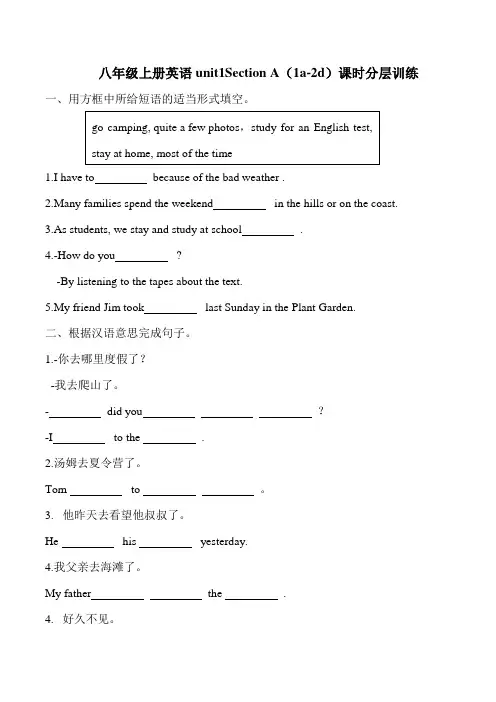
八年级上册英语unit1Section A(1a-2d)课时分层训练一、用方框中所给短语的适当形式填空。
1.I have to because of the bad weather .2.Many families spend the weekend in the hills or on the coast.3.As students, we stay and study at school .4.-How do you ?-By listening to the tapes about the text.5.My friend Jim took last Sunday in the Plant Garden.二、根据汉语意思完成句子。
1.-你去哪里度假了?-我去爬山了。
- did you ?-I to the .2.汤姆去夏令营了。
Tom to 。
3.他昨天去看望他叔叔了。
He his yesterday.4.我父亲去海滩了。
My father the .4.好久不见。
no .5.你去什么有趣的地方了吗?you go ?三、单项填空。
( )1. Where will your family go vacation?A. ofB.onC. atD. in( )2. Several years ago, people knew Li Yundi. But now he is well-known all over the world, not only in China.A.fewB. littleC. manyD. most( )3. went hiking last weekend because of the bad weather.A.SomeoneB. No oneC. EveryoneD.Nothing( )4.-Where would you like to visit?-I’d like to go .A.relaxing somewhereB. somewhere relaxingC.relaxing anywhere ( )5.-Did your father go to work yesterday?-Yes, .A. he didn’tB. he didC. he doesD. he do四、用所给词的适当形式填空。
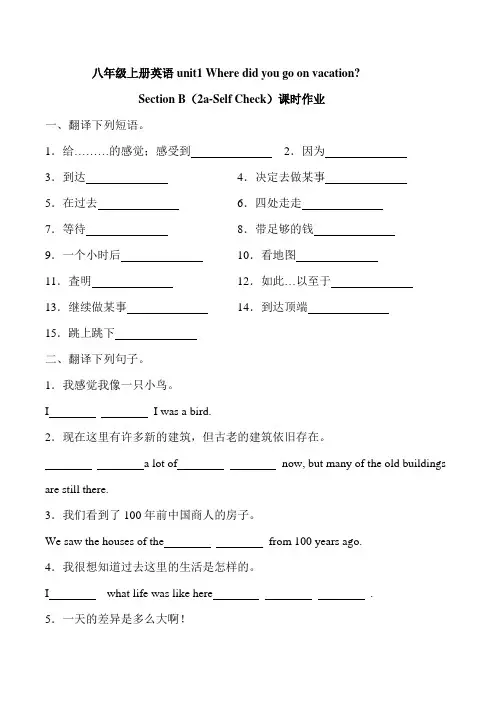
八年级上册英语unit1 Where did you go on vacation?Section B(2a-Self Check)课时作业一、翻译下列短语。
1.给………的感觉;感受到2.因为3.到达4.决定去做某事5.在过去6.四处走走7.等待8.带足够的钱9.一个小时后10.看地图11.査明12.如此…以至于13.继续做某事14.到达顶端15.跳上跳下二、翻译下列句子。
1.我感觉我像一只小鸟。
I I was a bird.2.现在这里有许多新的建筑,但古老的建筑依旧存在。
a lot of now, but many of the old buildings are still there.3.我们看到了100年前中国商人的房子。
We saw the houses of the from 100 years ago.4.我很想知道过去这里的生活是怎样的。
I what life was like here .5.一天的差异是多么大啊!What a day makes!6.我们没有雨伞,因此我们又冷又湿。
We so we were wet and cold.7.因为糟糕的天气,底下的东西我们什么都看不到。
the bad weather,we below. 8.你觉得这个旅行怎么样?did you about the trip?W9.(景色)太漂亮了以至于我们忘记了过去的五个小时。
It was beautiful we forgot about the last five hours!三、根据句意及首字母或汉语提示完成单词。
1. Look! There are some b flying in the sky. The spring is coming.2. -Why are you so wet?-It is raining outside and I didn’t take an u to school today.3.-I w how you study English so well.-If you work hard, you can do it, too4. I want to buy a new computer, but I don’t have (足够的) money.5. -What (活动) did you do in the park yesterday?-We took a walk and played tennis.四、用所给词的适当形式填空1. Why do you enjoy ( dance), Linda?2. Don't talk. My grandfather is trying (sleep).3. The tall (build)over there is our school library.4. There are some (different) between English names and Chinese names.5. The boy finds soccer (enjoy)and he often plays it with his friends.五、完成句子。
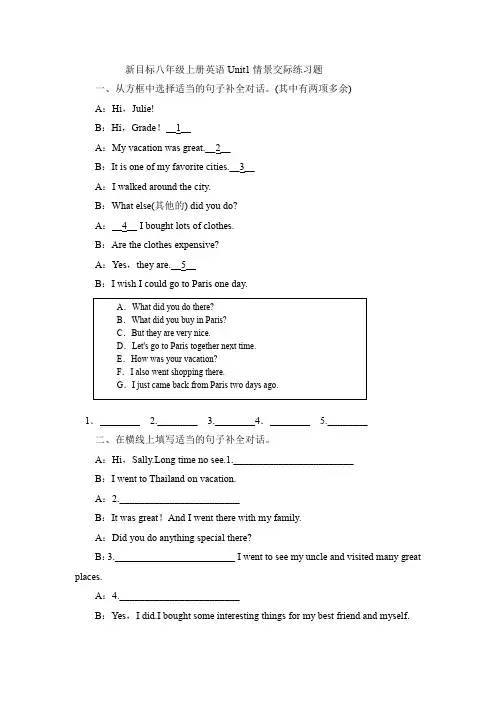
新目标八年级上册英语Unit1情景交际练习题一、从方框中选择适当的句子补全对话。
(其中有两项多余)A:Hi,Julie!B:Hi,Grade!__1__A:My vacation was great.__2__B:It is one of my favorite cities.__3__A:I walked around the city.B:What else(其他的) did you do?A:__4__ I bought lots of clothes.B:Are the clothes expensive?A:Yes,they are.__5__B:I wish I could go to Paris one day.1.________ 2.________ 3.________4.________ 5.________二、在横线上填写适当的句子补全对话。
A:Hi,Sally.Long time no see.1.________________________B:I went to Thailand on vacation.A:2.________________________B:It was great!And I went there with my family.A:Did you do anything special there?B:3.________________________ I went to see my uncle and visited many great places.A:4.________________________B:Yes,I did.I bought some interesting things for my best friend and myself.A:Did you take any photos?B:Yes.I took many photos there.A:5.________________________B:Sure.You can come to my house after school,and I'll show them to you.A:OK.三、在横线上填写适当的句子补全对话。
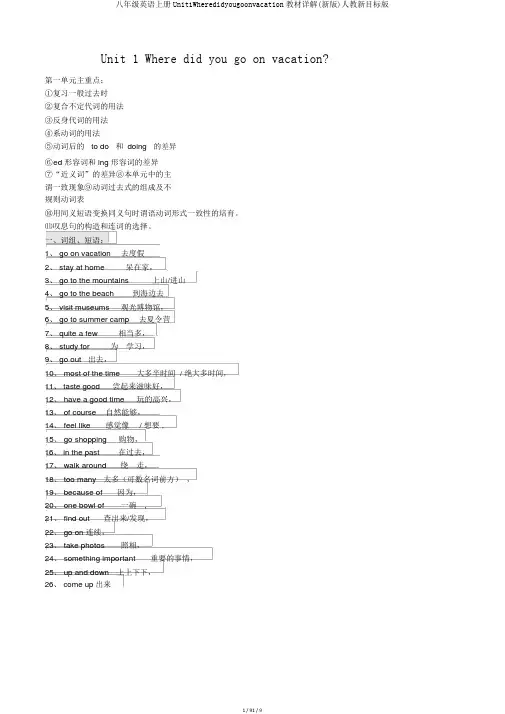
Unit 1 Where did you go on vacation?第一单元主重点:①复习一般过去时②复合不定代词的用法③反身代词的用法④系动词的用法⑤动词后的to do和doing的差异⑥e d 形容词和 ing 形容词的差异⑦“近义词”的差异⑧本单元中的主谓一致现象⑨动词过去式的组成及不规则动词表⑩用同义短语变换同义句时谓语动词形式一致性的培育。
⑾叹息句的构造和连词的选择。
一、词组、短语:1、 go on vacation 去度假2、 stay at home 呆在家,3、 go to the mountains 上山/进山4、 go to the beach 到海边去5、 visit museums 观光博物馆,6、 go to summer camp 去夏令营7、 quite a few 相当多,8、 study for 为学习,9、 go out 出去,10、 most of the time 大多半时间 / 绝大多时间,11、 taste good 尝起来滋味好,12、 have a good time 玩的高兴,13、 of course 自然能够,14、 feel like 感觉像 / 想要 ,15、 go shopping 购物,16、 in the past 在过去,17、 walk around 绕走,18、 too many 太多(可数名词前方),19、 because of 因为,20、 one bowl of 一碗 ,21、 find out 查出来/发现,22、 go on 连续,23、 take photos 照相,24、 something important 重要的事情,25、 up and down 上上下下,26、 come up 出来二、重要句子(语法):Where did you go on vacation? 你到哪里去度假了?I went to New York City. 我去了纽约城Did you go out with anyone? 你出去带人吗?No, No one was here. Everyone was on vacation. 不,没有人在这儿。
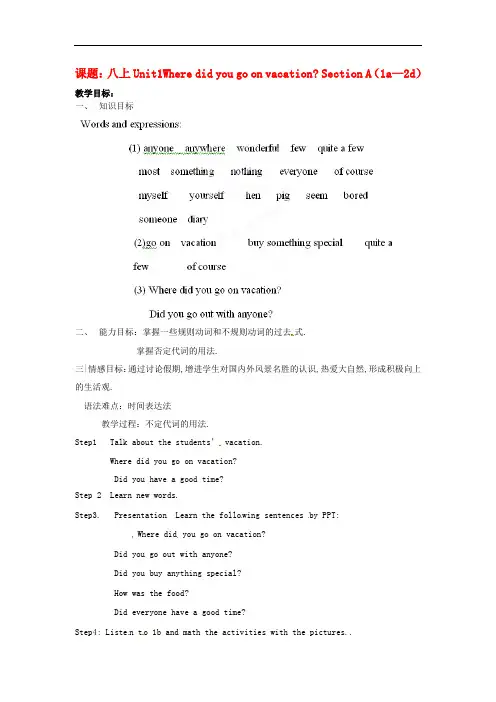
课题:八上Unit1Where did you go on vacation? Section A(1a—2d)教学目标:一、知识目标二、能力目标:掌握一些规则动词和不规则动词的过去式.掌握否定代词的用法.三|情感目标:通过讨论假期,增进学生对国内外风景名胜的认识,热爱大自然,形成积极向上的生活观.语法难点:时间表达法教学过程:不定代词的用法.Step1 Talk about the students’ vacation.Where did you go on vacation?Did you have a good time?Step 2 Learn new words.Step3. Presentation Learn the follo wing sentences by PPT:Where did you go on vacation?Did you go out with anyone?Did you buy anything special?How was the food?Did everyone have a good time?Step4: Liste n t o 1b and math the activities with the pictures..First let the Ss listen carefully..Then check the answers.Step5: Listen and number the people in the picture.Step6: Listening 2a and complete the chart..1.Step7:Listening ag ain . Check Yes or No for each question. Finish 2b. Step8: 2d Role-play the conversation.Step 9: Test 完成单词1.---Lisa, did you go a __________ last weekend?---Yes, I went to Hangzhou with my sister.2.I bought something for my friends, but n________ for myself.3.My daughter usually keeps a d_______ every day.4.The movie isn’t interesting a t all, so I feel b_______ about it.5.There are f________ students in the classroom. Th ey are all having a P.E. classon the playground.教学后记:。
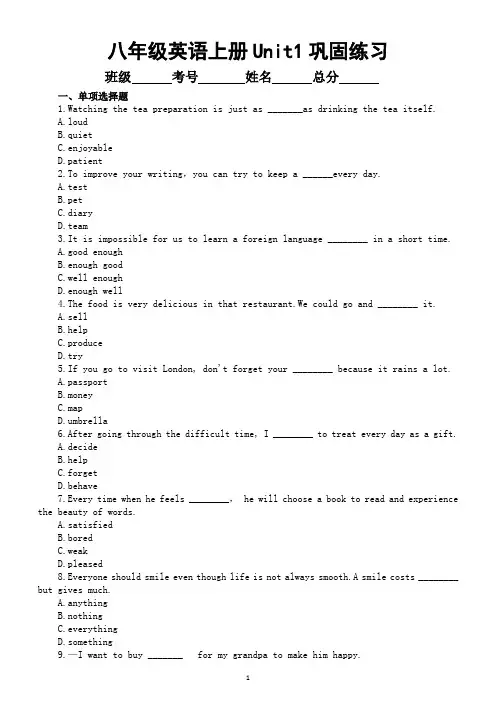
八年级英语上册Unit1巩固练习班级考号姓名总分一、单项选择题1.Watching the tea preparation is just as _______as drinking the tea itself.A.loudB.quietC.enjoyableD.patient2.To improve your writing,you can try to keep a ______every day.A.testB.petC.diaryD.team3.It is impossible for us to learn a foreign language ________ in a short time.A.good enoughB.enough goodC.well enoughD.enough well4.The food is very delicious in that restaurant.We could go and ________ it.A.sellB.helpC.produceD.try5.If you go to visit London, don't forget your ________ because it rains a lot.A.passportB.moneyC.mapD.umbrella6.After going through the difficult time, I ________ to treat every day as a gift.A.decideB.helpC.forgetD.behave7.Every time when he feels ________, he will choose a book to read and experience the beauty of words.A.satisfiedB.boredC.weakD.pleased8.Everyone should smile even though life is not always smooth.A smile costs ________ but gives much.A.anythingB.nothingC.everythingD.something9.—I want to buy _______ for my grandpa to make him happy.—That’s a good idea.A.something specialB.special somethingC.anything specialD.special anything10.—Who is at the door?—A deliveryman(快递员)or _______ wanting to sell his new products.A.everybodyB.anybodyC.somebodyD.nobody11.—Where would you like to go on holiday?—It's so cold here.I'd like to go _______ .A.somewhere warmB.warm somewhereC.anywhere warmD.warm anywhere12.David is a tennis player.He _______ to play tennis when he was six years olD.A.beginsB.will beginC.beganD.has begun13.—Is there _______ else in the classroom?—It’s empty._______is listening to a speech in the school hall.A.anyone; AnyoneB.anyone; EveryoneC.everyone; AnyoneD.everyone; Everyone14.—Amazing! Tom got the best grade in the test last week.— _______ is impossible.He studies really hard online this term.A.AnythingB.NothingC.EverythingD.Something15.—The teenagers clean up the city park every Sarturday.—Sometimes small things can make a _______ .A.promiseB.conversationC.differenceD.discussion16.—Let's go to the movies this weekenD.—Sorry, but my parents and I have decided ________ to Dongjiang Lake for camping.A.goB.goingC.to goD.went17.It was ______for us to solve the math problem.Few of us could even understand it.A.easy enoughB.enough easyC.difficult enoughD.enough difficult18.Most of us enjoy _______ to our mothers speak, because our brians greatly prefer the voices of our own mothers.A.listeningB.listenC.to listenD.listened19.We found that Nancy did very well in the math test ________ her hard work.A.becauseB.because ofC.as long asD.though20.Time ___________ for no man.But some people won't realize the importance of time until it's gone.A.leavesB.waitsC.searchesD.sends二、用所给词的适当形式填空1.I _____________(play) basketball yesterday afternoon .2.__________ you _____________(clean) your room last weekend?3.My mother _______________(watch) TV last night .4 My parents _____________(go)to London two days ago .5.What __________you_________(do) last weekend ?6.It _____ (be) rainy yesterday .7.She ________(stay) at home last night.8.He ________(take) many photos in Beijing last year.9.My daughter ________(not go) to school yesterday.10.Today I feel like ______(play) sports.Can you play ping-pong with me?附:参考答案一.单项选择题1-5 CCCDD 6-10 ABBAC11-15 ACBBC 16-20 CCABB二.用所给词的适当形式填空1.played2.Did,clean3.watched4.went5.did,do6.was7.stayed8.took9.didn't go 10.playing。
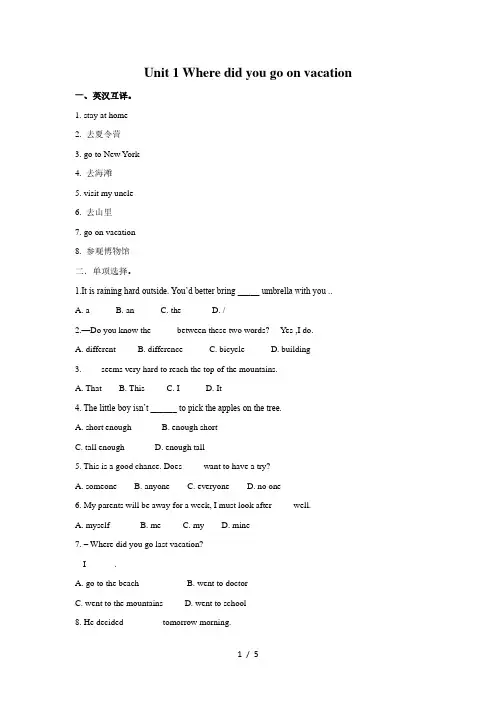
Unit 1 Where did you go on vacation一、英汉互译。
1. stay at home ________________________2. 去夏令营________________________3. go to New York ________________________4. 去海滩________________________5. visit my uncle ________________________6. 去山里________________________7. go on vacation ________________________8. 参观博物馆________________________二.单项选择。
1.It is raining hard outside. You’d better bring _____ umbrella with you ..A. aB. anC. theD. /2.—Do you know the _____ between these two words? ---Yes ,I do.A. differentB. differenceC. bicycleD. building3. ____seems very hard to reach the top of the mountains.A. ThatB. ThisC. ID. It4. The little boy isn’t ______ to pick the apples on the tree.A. short enoughB. enough shortC. tall enoughD. enough tall5. This is a good chance. Does ____ want to have a try?A. someoneB. anyoneC. everyoneD. no one6. My parents will be away for a week, I must look after ____ well.A. myselfB. meC. myD. mine7. – Where did you go last vacation?-- I ______.A. go to the beachB. went to doctorC. went to the mountainsD. went to school8. He decided ________ tomorrow morning.A. leaveB. leftC. leavingD. to leave9. He felt _______ when he saw the _______ film.A. boring; boringB. boring; boredC. bored; boringD. bored; bored10. he had to retire early ____ poor health.A. as a resultB. becauseC. soD. because of11.Would you like some Sichuan food ______ dinner.A. asB. forC. onD. in12. _____ seems difficult________ who broke the window.A. This; to find outB. It to find outC. That finding outD. It; finding out13. She isn’t very popular. She has _______ friends.A. fewB. a fewC. littleD. myself14.He doesn’t feel like ___ anything today..A. to eatB. eatingC. eatD. eats15. Lisa, do you have _____ to eat? I’m so hungry.–well, would you like to try some bread?A. any deliciousB. delicious anyC. anything deliciousD. delicious16. From the top of the hill we can see the whole city ______ us.A. underB. belowC. overD. above17. He was waiting _______ the bus stop _________ about 2 hoursA. for: forB. for: atC. at forD. for in18. Everything _____ free. Good luck to you!A. amB. isC. areD. be19. CCTV-10 often plays ______ around the world. It can help us learn more about not only nature but also different cultures and customs.A. new somethingB. something newC. anything newD. new anything20. They had great fun _________ volleyball on the beach.A. playB. playingC. playedD. to play21. The story was _________ interesting.A. a kind ofB. all kinds ofC. kinds ofD. kind of22. Tom found some boys _________ soccer on the playground.A. playsB. playedC. playingD. to play23. My sister helped me _________ English last weekend.A. studyB. studiedC. studyingD. studies24. The news makes me _________ sad.A. to feelB. feelingC. feelD. felt25. Kate decided _________ her homework first.A. doB. to doC. doingD. did三、按要求改写句子,每空一词。
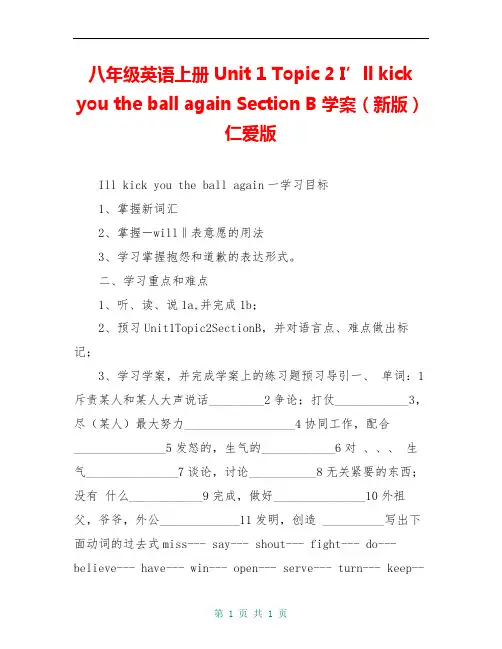
八年级英语上册Unit 1 Topic 2 I’ll kick you the ball again Section B学案(新版)仁爱版Ill kick you the ball again一学习目标1、掌握新词汇2、掌握―will‖表意愿的用法3、学习掌握抱怨和道歉的表达形式。
二、学习重点和难点1、听、读、说1a,并完成1b;2、预习Unit1Topic2SectionB,并对语言点、难点做出标记;3、学习学案,并完成学案上的练习题预习导引一、单词:1斥责某人和某人大声说话_________2争论;打仗____________3,尽(某人)最大努力__________________4协同工作,配合_______________5发怒的,生气的____________6对、、、生气_______________7谈论,讨论___________8无关紧要的东西;没有什么____________9完成,做好_______________10外祖父,爷爷,外公_____________11发明,创造 __________写出下面动词的过去式miss--- say--- shout--- fight--- do--- believe--- have--- win--- open--- serve--- turn--- keep--- hear---二、在文中划出下列短语并翻译1你什么意思_________________2对某人大吼_________________3尽力做某事___________________4与某人生气______________5谈论______________6向某人说对不起______________________7为我所说的道歉_____________________8没什么_____________9一个队员不能组成一个队_________________________10一定做某事__________________11玩的开心,有乐趣__________________12输给某人______________13在某人的帮助下___________________________1练习做某事_________________合作交流三、在文中找到下列句子并翻译总结1、What do you mean ? 译:_________________________________________点拨:mean---意思,意味 What do you mean saying that? by---通过(方式), 是介词, 后面的动词要用________形式。
新课程背景下教改学案年级:八科目:英语内容:Unit 1 How often do you exercise? 第一课时主备:校正:八年级英语组执教:八年级英语教师审核:预习内容:八年级新目标英语上册P1 Section A 1a-1c学习目标:1.掌握下列单词和句子。
单词: how often, exercise, skateboard , hardly, ever句子:What does she do on weekends ? She often goes to the movies.2.一般现在时和频率副词的用法重点难点: P1的生词和频率副词的位置。
Ⅰ.自主预习学案1.阅读教材: 1)认真预习单词 P99(5个)2)认真预习教材 P1 Section A 1a-1c并作好笔记。
2. 预习自测.必做题 A. 新的学期开始了,亲爱的同学请回忆一下我们七年级学过的一般现在时的用法。
完成下面的任务。
任务(一)1.当谓语动词为be动词时,其句型:主语+ be(am / / )+其它。
2.当谓语动词为实义动词/行为动词充当时,其句型:主语+(/ V-s / V- es )+ 其它。
3.标志性时间状语:always/ / / /等。
4.be动词特殊疑问句:特殊疑问词+ be(/is / are)+()+其它+?5.行为动词特殊疑问句:特殊疑问词+do/does +主语+()+其它+?我们一起来复习动词的第三人称单数形式的变化规则:1)一般情况,在动词词尾加s;2)以字母s, x, ch, sh, o结尾的动词,加es;3)以e结尾的动词,加s;4)以辅音字母加y结尾的动词,变y为i,再加es 5)以元音字母加y结尾的动词,加s;6)特殊:hav e→has are →is任务(二) 写出下列动词的第三人称单数1.drink2.play3.stay4.make5.pass6.brush7.watch8. go9.do 10.study 11.fly 12.have任务(三) 改写句子1. Tim is a good boy.→(否定句)→(一般疑问句)→(肯定回答)→(否定回答)2. Tom does his homework at home.→(否定句)→(一般疑问句)→(划线提问)必做题 B. 认真预习教材 P1,汉英互译。
Unit8Wheredidyougoonvacation?单元备课一、教材分析Unit8Wheredidyougoonvacation?的核心话题为“Talkingaboutholidays,vacationsandpastevents”,主要描述有关假期等过去的事情,学习和运用一般过去时,使学生学会谈论和交流过去发生的事情,让学生在交际活动中学会如何正确用英语谈论自己及询问他人过去的事情与经历,重在培养学生的语言运用能力、实践能力、合作能力及创新意识。
二、教学目标1.知识目标:1)掌握并能灵活运用本单元出现的重点词汇。
动词及它的过去式:stay(ed),visit(ed),go(went),do(did),is/am(was)2)用“Wheredidyougo...?Didyou...?”询问他人过去的经历。
3)掌握以下句式:(1)—Wheredidsb.go(onvacation)?—Sb.+wentto…(onvacation).(2)—Whatdidsb.do(onvacation)?—Sb.+verb+ed…(onvacation).(3)一般过去时的应用。
2.能力目标:学会谈论发生在过去的事情;能听懂以谈论假期做过的事情和谈论过去的事件及自己的感想为话题的语言材料,并获取相关信息。
能以“Talkingaboutholidaysandvacations”,“Talkingaboutpastevents”为话题与他人进行交流;能利用该话题进行情景对话及角色表演。
3.情感目标:本单元的教学内容与学生的实际生活息息相关,容易激发学生的兴趣,从而乐于运用简单的英语与他人进行交流。
学习活动中学生通过交换对过去发生的事情的描述及看法,从而促进学生之间和师生之间的情感交流,增进友谊。
三、重点和难点1.一般过去时及其应用。
注意:本课难点是动词过去式要加“ed”,而学生在描述过去时时容易遗忘动词的“ed”,在运用不规则动词过去式时容易直接加“ed”.2.运用一般过去时描述自己的假期情况及过去的事情。
Unit1 SectionB(2a-2e)全英版教案Teaching Aims1. Knowledge Objects(1) Function:Talk about past event.(2)Key Vocabulary:activity, decide, try, paragliding, bird, bicycle, building, trader,wonder, difference, top, wait, umbrella, wet, below, enough, hungry, as, hill, because o f,Hong Kong, Malaysia, Malaysian, Geogretown, Weld, Penang.(3)Target Language:①What do people usually do on vacation?②They usually have a trip.③What activities do you find enjoyable?④We go to the beach and try paragliding.(4)Structure:①Use “ why, what, where” to make questions and answers.②indefinite + adj.2. Ability ObjectsDevelop the abilities to describe an event and tell why you like or don’t like an3. Moral ObjectsExpress their feelings about the vacation with students.Teaching Key Points1. Vocabulary and expressions.2. Target language:(1)Where did you go on vacation?(2)I went to summer camp. Did she go to Central Park?(3)Yes, she did. / No, she didn’t.Teaching Difficult PointsUse the past tense to talk about some activities with the following sentences :1. Where did you go on vacation?2. Did you go to...? Yes,... /No,…Teaching MethodsSituation teaching method. Encourage the students to talk about their vacations, and askthem: “How do you think about your vacations? And why?”Teaching Aids1. Some pictures of beautiful view which we visited.2. A tape recorder.Teaching ProceduresStep 1 Greeting (about 2 minutes)T:Good morning, class!S:Good morning, teacher!T:Do you like vacation?S1:Yes.T:Do you enjoy your trip?S2:Yes.Step 2 2a (about 6 minutes)T:Where do you usually do on your vacation?S1:I usually visit my uncle in Shanghai.S2:I go to summer camp.S3:I go to the beach.T:It is wonderful! Well, what activities do you think enjoyable?S1:Swimming. I like swimming in the river.S2:Go shopping. And I always buy many interesting things.T:This is a writing of Janet’s diary. Let’s read the text, and think:Did Jane have a goodtime on Monday? What about on Tuesday?Objects:Review the simple present tense.Attention:Some students may be confused. So the teacher should summarize the simple present tense and past tense.Step 3 2b (about 8 minutes)Read the new words, then read the text and know each sentence. F ind the important phrases, then learn them.T:Now let’s read the new words from “activity, decide, try, paragliding, bird, bicycle, building, trader, wonder, difference, top, wait, umbrella, wet, below, enough, hungry, as.T:Read the text and know each sentences of the text. You have three minutes to finishthen. If you don’t understand the meanings, you can ask your classmates or the teacher.T:Then let’s read the text again, please find the important phrases, and talk with your desk mates, then share your work with us.T:Which phrase is important?S1:decide to do...T:What’s the Chinese meaning?Students explain.T:Can you give an example?S1:It is raining heavily, but we decide to go out to eat dinner.T:Good job.Learn the other phrases like this.T:Read the text again. Then answer the questions you have. (key:1. Yes, she did. 2. Jane didn’t have a good time because of the bad weather.)Objects:Learn the new passage, and phrases.Attention:Some important phrases like decide to do, try doing, feel like, enjoy doing, because of....Step 4 2c (about 10 minutes)Read the passage again and finish 2c.Pay attention to these phrases:(decide to do, decide on, try doing, try to do, try one best to do, feel like, look like, enjoy doing, start doing, because of, enough + n. ) the teacher should make examples for students. And then the teacher can design some exercise to help the students to learn them.e. g.:decide to do:We decided to buy a new book for our teacher.try doing:My little sister tried riding the bike.try to do:We tried to open the door with the key.:I tried my best to study well.try one’s best to dofeel like:I felt like I flew into sky.look like:The flower looks like a butterfly.enjoy doing sth.:They enjoyed playing basketball.start doing sth.:Let’s start reading.because of:We can’t climb the mountain because of the bad weather.enough+ n.:We didn’t have enough time to go shopping.Objects:Emphasize the important phrases.Attention:Expand some phrases. These phrases are also important.Step 5 2d (about 5 minutes)。
八年级上册英语unit1 Where did you go on vacation?Section A(Grammar Focus-3c)课时作业一、翻译下列短语。
1.记日记2.尝起来很好吃3.玩得高兴4.当然5.去购物6.为……买7.唯一的问题二、翻译句子。
1.我给父亲买了一些东西。
I bought my father.2.每个人都玩得高兴吗?Did everyone ?3.(你觉得)食物怎么样?was the food?4.你为什么不给你自己买点东西呢?Why you buy for yourself?5.唯一的问题就是晚上无事可做,除了看书。
was that there was to do in the evening but read.6.即使这样,仍然没有人看上去很无聊。
Still no one bored.三、根据句意及首字母或汉语提示完成单词1. There is s wrong with my bike. It doesn't work.2. Do you have anything to say for y , Jim?3. I think n is impossible if you put your heart into it.4. Not (每个人) is interested in the film.5. Lucy (好像) a little unhappy today.四、单项选择()1. I went to the countryside my family on vacation and we had a good time there.A. forB. withC. fromD. to()2. Is there in today s newspaper?A. special somethingB. special anythingC. something specialD. anything special()3.-How is the food? -It delicious.A. tastesB. looksC. soundsD. feels()4. Kaylee is new here, so I know about her.A. nothingB.somethingC. anythingD. everything()5. -The book is a bit difficult, you read something easier?-All right.A. Why not toB. Why don’tC. Why notD. Why not you五、完成句子。
新目标八年级上册英语Unit1所给词填空与完成句子练习题用括号内所给单词的适当形式填空。
st week we went to two famous ___ (beach).2.Today is Mike's birthday.I want to buy him a ________(specially) present.3.His parents work in the ________(center) city of France.4.Listening to some music can help you ________(relaxing).5.His mother watches TV every evening,but she ________(not watch) TV last night. 6.Can you find a ________(different) between the two pictures?7.Alice always ________(try) to help me to learn English well.8.Are there any ________(bird) in the tree?9.Living in the village is boring,so she _____ (like) it.10.Those children go to school by _____(bicycle) every day.11.There ________(be) quite a few students in the library that day.12.Sam and David ________(come) to China last month.13.My sister ____(not do) housework yesterday.14.His brother __(watch) TV yesterday evening.15.—When ________ they ________(get) to Hubei yesterday?—They ________(get) there at four o'clock in the afternoon.16.How many ________(duck) are there on Uncle Wang's farm?17.The weather in Heilongjiang is kind of ________(difference) from that in Hubei. 18.What do you think of these after-school ________(activity)?19.His brother wants to be a ________(trade) after he leaves the school.20.I am sure Mr.Zhou lives in this tall ______ (build).21.Kevin ______(watch)TV every evening.22.I am ___(arrive)in Beijing at 8:00 tomorrow.23.He ______(go)to the movies yesterday.24.It ______(rain)heavily last Sunday.25.The musician ______(seem) to write a new song last month.26.He decided ______ (climb) the mountains.27.They tried ______ (do) the experiment,but failed.28.Today I feel like ______(play) sports.Can you play pingpong with me? 29.The foreigner ______(wonder) how many ______(wonder) there are in the world. 30.We can't wait _____(choose) the new skirts.31.We decided _______(go) to the beach near our hotel.32.I really enjoy ______(walk) around the town.33.We wanted _______ (walk) up to the top.34.My family__(go) to the beach every summer.35.Did you have a great time _______ (talk) in groups?36. Lucy usually_ ______to school early. But today she ________to school late. (go)37. ---Where did you______ (study) last night?---No,I________(help)my mother_______(clean) the room.38.Do you feel like______(drink) some orange?39.Our teacher often keeps us _______(read) English in the morning.40. It’s very interesting _____ ( feed) the pets.41.My mother and I ______(be)in Beijing last Sunday.42.We ______(see)an interesting movie on TV yesterday.43.Did they go to the beach with ____ (someone)?44.I think the movie is too ______(wonder).45.Jack,please help ______(you) to some fruit.46.We all like the activity and nobody gets ______(boring).47.I want to make my ____(decide) for myself.48.They are _____(difference) from each other.49.His brother really enjoyed ______(walk) in the rain.50.Hurry up!Tom ______(wait) for you in the office.用所给动词的适当形式填空, 完成短文。
Unit 1 How often do you exercise? 第1课时 Unit 1 Section A 1a-2c Teacher's words : Practice makes perfect. 【Learning objectives】 Knowing : 本课的11个单词与9短语 Habit----forming: ① A: What do you usually do on weekends? B: I often go to the movies. ② A: How often do you watch TV? B: Twice a week Practising: 熟练 运用本课词汇 及句型谈论活动及其发生的频率。. 【Important points】频率词汇及询问活动频率 【Difficult points】一般现在时态的熟练运用 【Learning process】 一、自主学习 Task 1. 学习1a-1c: 谈论日常行为活动 1、看图画,写出活动词汇 a __________________ b __________________ c___________________ d __________________ e go skateboarding 2、了解下列频率副词,写出其汉意 always (100%) usually (80%) often (30-50%) sometimes (20%) hardly ever(5%) never (0%) 听听力,与1中的活动完成搭配。(只写1中的字母代号) always_____usually _____often____ sometimes ____ hardly ever_____ never ___ 3、两人一组,利用短语;仿照下列句型谈论日常活动。(注意;第三人称替换) A: What do you usually do on weekends? B: I often go to the movies. A: What does he usually do on weekends? B: He often goes skateboarding. Task 2. 学习2a-2c:学习频率副词,利用How often.........?句型谈论活动频率。 活动设计: 1、写出下列频率副词 总是_____ 通常________ 经常______ 有时________ 几乎不______ 从不______ 2、写出下列表示频率的副词短语 每天: 一周一次: 一周两次: 一周三次: 一月一次: 一月两次: 3、首先个人迅速理解下列词汇,然后听录音,给活动词汇排序。再听完成搭配(只写 字母) Activities How often a. ________ go to the movies every day b. watch TV once a week c. _______ _ shop twice a week d._________exercise three times a week e. read once a month twice a month 4、理解下列询问频率的句型,并仿照练习(注意:第三人称替换) A: How often do you watch TV? B: Twice a week. 5、读2c对话,理解并仿照练习 网上冲浪 :surf the Internet 二、合作共建 1、你知道频率副词的位置在哪儿吗?将下列词组成句子。 (1) is late always he for school .______________________________________. (2) homework Gina school does often at _____________________________. 2、区别下列有关how的短语 how many _______ how much ______ how often ____how old ________ how long_____ 三、系统总结 1、写出本课的频率副词:
2、本课的两个重点句型:(1) (2) 四、诊断评价 (4)网上冲浪_____________(5)一周一次 _____________(6)一月两次 _______ (7)一周三次_______________(8)在周末 ______________ 2、单项选择 (1)-_____ do you do your homework? --- Every day. A.When B. How often C. How many times D. What time (2) I visit my grandparents _________a month. A. two times B. second time C. the second time D. twice (3)One of my favorite programs ________ Animal World. A. am B. is C.are D. don't 3、用下列词填空(surf , program , once , result , health ) (1) My grandma is pretty _____ because she exercises every day. (2) ---What's your favorite TV_______? --- It's CCTV news (3) Here are the ______ of the students' activity at Hilltop School. (4) He hardly ever ______ the Internet. (5) ______ a year,they have a Christmas Party. 五、课后反思
第2课时 Unit 1 Section A 3—4 【Learning objectives】 Knowing : 本课的8个单词与短语 Practising: 熟练运用频率副词 【Important points】 能运用本课词汇 及句型进行自由交际对话. 【Difficult points】一般现在时态的熟练运用 【Learning process】 一、自主学习 Task 1. 会读写本课单词及短语 (1)个人记读单词3分钟 (2)两人一组相互检查读音 (3)展示,写在学案上 单词:大多数的;大部分的;几乎全部的 结果;成果 活跃的;积极的 对于;关于 约摸;大约 短语:每天 一周一到二次 一周三到四次 在格林高中 至于;关于 大多数学生 一些学生 Task 2. 学习 3部分 1、利用所给数据填all、 most 、some、或 no all=100% most=51%--99% some=1%--50% no=0%
Activity Every Day Once or Twice a Week Three or Four Times a Week
Exercise 15%( ) 10%( ) 75%( ) Do homework 95%( ) 0%( ) 5%( ) Watch TV 85%( ) 2%( ) 13%( ) 2、(1)根据表格1完成短文 (2)a.Here are the results of the student activity survey at Green High School.该句为倒装句,其主语为the results of the student activity survey."Here+be+主语"是英语中常见的倒装句型。 例如:高小姐,送给你一些鲜花。 。 b.As for homework至于家庭作业:as for意为“至于,就„„而言”,后接名词或代词构成介词短语,置于句首,作状语。 例如:至于牛奶,我很喜欢。 。 c.The results for "watch TV"are interesting.“看电视”的结果很有趣。 介词短语 for "watch TV"作后置定语,修饰the results.介词 for此处表示作用、用途,意为“供,适合于”。例如:我没有钱打车,所以我步行回家了。 。 (3)复述课文 Task 3. 学习4部分 在小组内展开调查,完成表格, 并 根据调查结果写一篇作文 所需语言结构 A:How often do you read English books? B: I read English books about twice a week
How often do you once a week twice a week three times a week once a month read English books
二、合作共建 all, most ,some, no这四个词的区别 三、系统总结 请你写出所学的表频率的副词(至少写10个)及表多少的词
四、诊断评价 1、选择 1) The twins' uncle every day. A、exercise B、exercises C、is exercise D、is exercises 2) do you go to the movies? A、How mang B、How often C、How much D、How 3) I think I am . A、Health B、not health C、healthy D、healthest 4) My mother wants me . A、drink B、not drink C、drinks D、to drink 5) Jim is a good student. He late for class. A、is hardly ever B、is not ever C、is ever D、is always 6) There a lot of junk food on the table. A、are B、have C、is D、has 7) homework , we do it on Sunday. A、As for B、As to C、As of D、As from 8) How often do you play soccer . A、two time a week B、twice a week C、a time a week D、one time a week 2、补全句子 1)我每周购物一两次。 I shop a week. 2)“看电视”的调查结果很有趣。The "watch TV" are very . 3)对于家庭作业,大多数学生每天都做。 homework, students do every day. 五、课后反思